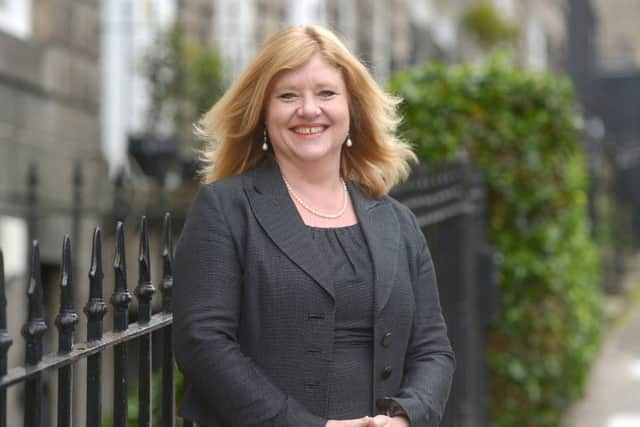How Scotland is tackling the gender agenda


First Minister Nicola Sturgeon recently called it “a fight as yet unwon” and, although significant strides have been made in increasing female representation in parliament, councils, the media, public sector and in boardrooms, statistics show that equality in numbers at high levels in almost every sector of public life is a long way off.
In Scotland, only about a quarter of FTSE 100 company directors, public body chief executives, university principals, sheriffs and councillors are women.
Advertisement
Hide AdAdvertisement
Hide AdThere are no major newspaper editors or chief executives of FTSE 100 companies and only 7 per cent of senior police officers are women.


Even with Scotland’s line-up of female political leaders, inequality of representation is evident at the highest levels of public life. Just 35 per cent of MSPs are female, down from 40 per cent in 2007.
Talat Yaqoob, chair and co-founder of Women 50-50, a cross-party group set up in 2014 to promote 50 per cent representation across the Scottish Parliament, councils and public boards, says that achieving parity in gender representation in politics is a matter of social justice.
“Women are half the population and if we don’t make up half the decision-making in public policies affecting all of us, then our experience and expertise is not being recognised.
“If we waited for the balance to occur naturally it is likely to take 50 years before we get fair representation.”


Instead, Women 50-50 is campaigning for positive action to speed up the process.
As well as lobbying political parties, it has sent draft bills to promote gender equality to the 32 councils with a request that the proposal be debated in the chamber.
Edinburgh, Stirling and North Ayrshire councils have so far voted to pursue outreach policies to encourage female representation.
Advertisement
Hide AdAdvertisement
Hide AdYaqoob says it is not just about politics. “Whether it is a political party or a private board, it is about persuading individual people or companies to take the lead on this.
“There is a social and business advantage to both political bodies and companies, and sometimes it takes one firm to do it, which will then cause their competitors to follow suit.”
Such a lack of female representation at the higher levels in business leads to an almost inevitable gender pay gap, which is also evidence of a stubborn resistance to progress.
Whereas unequal pay is the practice of paying men and women differently for performing the same work and is illegal, a gender pay gap is a measure of the difference between the average hourly earnings of men and women.
The gap, which shows that UK women earn on average 18 per cent less than men, exists mainly because women tend to work in lower-paid occupations and sectors, and occupy less senior roles.
Yaqoob says: “Women are over-represented in underpaid jobs and under-represented in higher paid positions of power across the board.”
While it is true that many women take time out of the labour market and work part-time because of care responsibilities, stereotypes and workplace culture are also factors.
Yaqoob says: “Expectations are a big part of it too. We have objectification in the media and a lack of female role models in powerful positions.
Advertisement
Hide AdAdvertisement
Hide Ad“So women can grow up with a self-stigmatising cap on their ambition and face sexism in the workplace. Changing these attitudes has to be reinforced from a young age.”
One way to encourage companies to close the gender gap at higher levels is to point out sound business advantages.
Studies conducted on the effects of the imbalance do suggest that increasing the number of women at the top of an organisation can pay dividends.
The management consultancy McKinsey & Co found in 2015 that companies with the most women on their boards outperformed those with no female representation across all sectors.
In the original research, using 2014 diversity data, it found that companies in the top quartile for gender diversity on their executive teams were 15 per cent more likely to experience above-average profitability than companies in the fourth quartile.
Using more recent data and a larger sample of companies, this number rose to 21 per cent in 2017.
The report also put forward a causal link between higher numbers of women in the boardroom and better financial results, stating: “Our hypotheses about what drives this correlation were that more diverse companies are better able to attract top talent; to improve their customer orientation, employee satisfaction and decision-making; and to secure their licence to operate.”
Other research shows that a more diverse and inclusive workforce helps business by bringing new skills, creativity and innovation, and achieving higher staff retention.
Advertisement
Hide AdAdvertisement
Hide AdMoving towards parity at top positions is not only likely to help the company’s performance, it could bring in added tax revenue.
McKinsey estimates that closing gender gaps in work could add £150 billion to UK gross domestic product in 2025.
Perhaps not unsurprisingly, the UK government is taking steps to encourage closing the gender pay gap, which goes hand in hand with promoting greater representation of women in power.
New gender pay reporting legislation requires employers with 250 or more employees to publish figures every year showing how large the pay gap is between their male and female employees.
The deadline for the first report is 4 April and figures must be published on the employer’s own website and a government site.
Making each company’s gender pay gap publicly available is designed to encourage employers to take new or faster actions to reduce or eliminate their gaps.
Employers have the option to provide a narrative with their calculations, explaining the reasons for the results and giving details about actions that are being taken to reduce or eliminate the gender pay gap.
Other organisations are working hard to encourage more female representation.
Advertisement
Hide AdAdvertisement
Hide AdThe 30% Club was launched as a campaign in 2010 with the aim of achieving a minimum of 30 per cent of women on FTSE 100 boards – the figure now stands at 27.9 per cent, up from 12.5 per cent eight years ago.
Women are also being encouraged to start or grow their own businesses. Jackie Waring, the chief executive and founder of Investing Women, Scotland’s only all-female angel investing group, says progress is being made when it comes to bolstering the number of female business leaders but there is still much work to be done.
She says: “Women’s Enterprise Scotland research shows that, if we could increase the number of female-led businesses to the same level of those run by men, we’d see a 5 per cent boost to our economy, equivalent to a rise of £7.6bn.”
Her involvement in looking at the value of women-founded companies started in the early 1990s when she carried out research for the UK government on the links between women’s enterprise and the Scottish economy.
She says: “We interviewed 500 women entrepreneurs and found that, loud and clear, one of the main issues they had was access to finance, so we set up Investing Women to speed up the process of growth.”
She says that having a board of women-only investors does affect results.
“Data from the US has shown a correlation, that an increase in the number of female investors does mean a rise in female-led companies getting financial backing.
“It is more an echo effect, rather than direct, so it is just not women giving money to women, but the setting up of an environment which encourages belief, and the channels and networks that all go towards a much more amenable environment in which women-led companies can grow.”
Advertisement
Hide AdAdvertisement
Hide AdInvesting Women doesn’t just offer help to female-led companies but about 80 per cent of their investments goes to companies founded or co-founded by women.
Waring says: “I think there was a perception that women in business are more risk-averse, but that is a misreading.
“Our experience is that they tend to be more about risk management. Data in Silicon Valley suggests that over a ten-year period the returns on women-led businesses are 63 per cent higher than the average.”
Investing Women runs a programme, now in its third year, called AccelerateHer to celebrate the most promising women-led businesses in Scotland.
Waring says that the £10 million of investment that Investing Women – alongside other funding sources – has so far overseen has gone to a diverse range of companies.
“This year, among the nine finalists we are delighted that there are a number of tech and biotech companies, which is a sector where women have historically been under-represented, but these are high-growth firms of an international calibre.”
Other finalists in the programme have been companies where a woman’s life experience has been able to spot a gap in the market.
Waring points to Alex Feechan who, as a fashion designer and keen mountain biker, found the range of cycling clothing unsatisfactory as it was usually adapted from men’s clothing but coloured pink – the “shrink it and pink it” approach. Feechan founded Findra sportswear in 2014 to address the gap with a high quality designer product and, with the help of Investing Women, the award-winning company has attracted hundreds of thousands of pounds in investment from TRICapital, the Scottish Investment Bank as well as Investing Women, which is being used to expand key markets and launch its products globally.
Advertisement
Hide AdAdvertisement
Hide AdWaring predicts that, with increasing numbers of women founding companies, the business ethos will also inevitably change.
She says: “I think that in the past the juggling that women tend to have to do – to look after children or elderly parents – has led to the sort of flexible working that might appear to be somehow not serious or ambitious.
“But you think about pioneers such as Anita Roddick of The Body Shop who set up a global company from her kitchen table and see that the attitude is wrong and that business models are changing.
“Technology increasingly helps women who are having to juggle, but there is a shift in attitudes with a younger generation too and I can see families moving to more equal responsibilities in caring.
“Female entrepreneurs have a lot to offer, not least because many entrepreneurs are driven by a motivation to help others, and women have always excelled at that.”
This article appears in the Spring 2018 edition of Vision Scotland. Further information about Vision Scotland here.